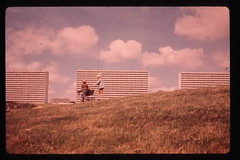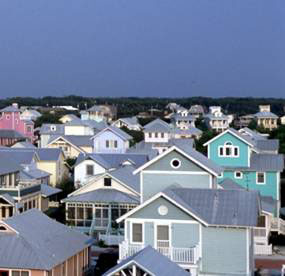Planning: is it looking forward or looking backward, or is it merely a matter of paying attention?

Towers in the Park, Denmark. Photo source unknown.
From Ken:
Yesterday in Planning History class the instructor made the point that for most of the 20th century planning looked to the future. Now, it is more looking to the past. What do you think?
Me:
That's a very interesting point, but I don't think it's the only way to look at this. The other way to think about it is to look at the characteristics that make up a successful city.
In good part it is physical -- urban design, architecture.
But architectural design is about style too, and yes, most of the styles are "in the past."
The components and characteristics of quality urban design were developed over millennia, and in the U.S., from the start of the founding of the country, through the Walking City (1800-1890) and Transit City (1890-1920) eras. After the introduction of mass produced cars, cities began to be developed in favor of accommodation of automobiles. In the DC region, and in DC proper, you can see the difference in how the core of the city was developed, versus the outer parts of the city, such as in Brookland or Woodridge.
But it's a mistake to consider the focus on urban design -- zero setback lot lines, small blocks, smaller houses, connected street network, density, etc. -- to be some kind of nostalgic return to the past. Since New Urbanists are found of older architectural styles, people often look to the style rather than to the underlying physical design of the community, at macro and micro levels, from the streets and the provision of public facilities, amenities, and the quality of the public spaces, to lot sizes, house sizes, placement of houses on lots, and how the house is presented and connects to the street and to the area around it.
Another way to think about this is to look at the work of the Project for Public Spaces, which doesn't focus on historic preservation or architectural style at all, except in the context of livability, what they call placemaking. Same goes with Dan Burden, the walkability guru -- I've never ever heard of him being referred to as a new urbanist. But his work is also essential in helping to refocus land use and transportation planners towards design for livability rather than for automobility.
Corbusier was wrong about tower in the park, and focusing on the car... if you want to make places that are great for people, you have to focus on people, rather than having people be afterthought, the occupants of habitable sculpture.
Lots of planners and architects, especially professors, make a big mistake when considering new urbanism (their conference is going on right now in Austin, Texas) almost solely in terms of the "traditional neighborhood design" as expressed through architectural style.

The construction of Seaside, the first "New Urbanist" community on the Florida coast, began in 1982. Photo source unknown.
It's about urban design first and foremost. The styles of the building are something else. There are even a couple somewhat modernist style versions of New Urban communities.
Zero setback design, for subdivisions moving accommodation of the automobile to the rear of the property through alleys, focusing on walkability, small blocks, street grid, etc., this has nothing to do, really, with "the past" and everything to do with the characteristics of successful communities.
I militantly call myself an old urbanist, committed to the revitalization and repopulation of center cities, in counter to the fact that most new urbanists work on large greenfield subdivisions, I mean "traditional neighborhood design" developments in far suburbs. (Of course, that's where the available land is, and developers tend to work with large tracts.)
But I think it is fair to say that New Urbanists have been key to the reviving of the recognition of the value of traditional urban design principles.
They weren't and aren't the only ones. But there is no question that if not even the innovators (see the work of Everett Rogers on the diffusion of innovation), people like Andres Duany were the early adopters and the "salesmen" (see Gladwell's Tipping Point for a good discussion of how to accelerate the diffusion of innovation) that have spurred the recognition of the value of urban design principles.
Also see Kuhn's The Structure of Scientific Revolutions.
Maybe professors are somewhat miffed that they didn't make the change, or make the change happen, but watch and observe. After all, architecture and planning schools think of themselves as practitioners, not just observers.
Speaking of a great book produced not by a professor, Cy Paumier's (he is a consultant for the Downtown DC BID) Creating a Vibrant City Center, is a great place to start with in terms of understanding the principles of great urban design.
Labels: innovation, sustainable land use and resource planning, urban design/placemaking



0 Comments:
Post a Comment
<< Home